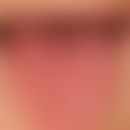Synonym(s)
HistoryThis section has been translated automatically.
DefinitionThis section has been translated automatically.
You might also be interested in
PathogenThis section has been translated automatically.
Especially caused by Borrelia afzelii.
Occurrence/EpidemiologyThis section has been translated automatically.
Incidence (Europe): about 10/100.000 inhabitants/year. Common in Borrelia endemic areas, especially in some wooded areas of Austria, Poland and Eastern Europe.
Acrodermatitis chronica atrophicans is extremely rare in North America (the pathogen is B. afzelii, which is not common in America).
ManifestationThis section has been translated automatically.
In about 10% of (untreated) Lyme borrelia infections, atrophic chronic borreliosis develops with the appearance of acrodermatitis chronica atrophicans.
Occurrence is possible at any age, especially in the 5th-6th decade of life; women are preferentially affected (Strle F et al. 2013).
Occurrence usually months to years after infection (stage 3 of Lyme disease).
LocalizationThis section has been translated automatically.
Distal extremities (Strle F et al. 2013) and acra, often symmetrical.
Clinical featuresThis section has been translated automatically.
Infiltrative (edematous) stage: Months to years after the primary stage, circumscribed, rather discrete, palm-sized , poorly defined, nonsymptomatic, brownish-red, succulent, non-scaling erythema and plaques form at initial diagnosis (if recognized as a Borrelia infection). These are often misinterpreted as "chronic venous insufficiency" in the lower extremity. If left untreated, the lesions gradually spread to extensive, often encompassing an entire body part, edematous, indistinctly circumscribed, causing little discomfort, livid red plaques with a shiny surface.
Atrophic stage: after months of persistence, barely noticeable transition to a peculiar shiny, thinned, hairless (follicles are destroyed), atrophic skin stage. Striking (and eponymous) is a crinkled wrinkling of the brown-red discolored skin, with clearly translucent vessels. The superficial veins run under this atrophic skin, as oddly imposed sinuous strands otherwise found only in the withered skin of very old people. Allodynia, an exaggerated burning pain reaction to trivial stimuli, is common.
Morphea-like acrodermatitis chronica atrophicans: in this particular and rare variant, there is not the characteristic atrophic condition of acrodermatitis atrophicans, but a reactive "morphea-like" sclerosis of the skin. Dermal changes may occur on the trunk, but also on the distal extermities (lower leg and dorsum of the foot). Especially on the trunk, these foci are difficult to distinguish from the plaque type of morphea (histology with plasma cell dominance, positive Borrelia serology).
Optional Concomitant Symptoms:
It is one of the unexplained peculiarities of this disease that, in addition to the extensive atrophy of the skin and subcutis (in an untreated state) that characterizes the clinical picture, they form focal connective tissue proliferations, so-called fibroid juxtaarticular nodules. These are nodes up to the size of a walnut, possibly calcifying, especially over the elbows.
Furthermore:
- Secondary skin changes: loss of hair follicles, sebaceous and sweat glands, dry skin.
- Tendency to exsiccation eczema.
- Torpid ulcerations due to minor trauma.
- Frequent pseudolymphomas of the skin, lipoma, fibroma, carcinoma, transition to malignant cutaneous B-cell lymphoma possible.
- About 50% of infected persons suffer from axonal peripheral neuropathy (mostly lesional).
- Disseminated neuropathy is rarer.
LaboratoryThis section has been translated automatically.
Strong increase of gamma globulins and BSG by stimulation of the B-lymphocyte system with maturation of plasma cells. High antibody titers against Borrelia antigens (IgG).
HistologyThis section has been translated automatically.
Inflammatory-oedematous stage: epithelium little widened, orthokeratosis. Edema of the dermis with vascular dilatation. Characteristic are interstitial granulomatous infiltrates(CD68 positive), with uniquely thickened and homogenized collagen bundles, and a band-like infiltrate of CD4 positive T-lymphocytes. Vacuolated degeneration of the basal cell layer in places. Plasma cells are not always detectable. In a larger study (Brandt FC et al. 2017), plasma cells were absent in 9 of 22 biospies. B. afzelii, serotype 2 is preferentially detected.
Atrophic stage: epidermal atrophy with compact orthokeratosis; increasing loss of elastic fibers. Rather sparse, diffuse inflammatory infiltrate of lymphocytes and plasma cells.
Differential diagnosisThis section has been translated automatically.
- Clinical differential diagnosis:
- Acrocyanosis: no atrophy of the skin; preferred acral localization; Borrelia serology neg.
- Perniones: circumscribed plaques or nodules, no skin atrophy, variable course.
- Stasis dermatitis in chronic venous insufficiency: CVI-sign, only lower extremity affected, almost exclusively bilateral, brown colour, possible ulcer formation.
- Erysipelas: acute course, fever, painfulness, painful lymphadenitis, leucocytosis, CRP significantly increased.
- Erythromelalgia: typical reproducible pain symptoms, positive cold water test.
- Circumscribed scleroderma type Atrophodermia idiopathica et progressiva: strain-specific localisation, negative serology and PCR.
- Histological differential diagnosis:
- Lichen planus: prominent interface dermatitis with pronounced vacuolisation of the basal keratinocytes; no plasma cells.
- Lichenoid drug reaction: usually marked dermal edema; often eosinophilia, no plasma cells.
- Mycosis fungoides: typical halo formation around polymorphic lymphocytes, hardly any plasma cells, marked epidermotropy with vacuolated epidermis cells; eosinophilia is possible.
- PLEVA: no histiocytes, no plasma cells.
- Syphilitic exanthema: interface dermatitis with high infiltrate density, psoriasiform epidermal reaction, numerous plasma cells.
- Atrophodermia idiopathica et progressiva: rather thin, lympho-histiocytic infiltrate, clumped collagen fibre bundles in the deep dermis; atrophic, hyperpigmented surface epithelium.
Internal therapyThis section has been translated automatically.
Ceftriaxone (e.g., Rocephin) is the first-line therapy, even in the presence of concomitant extracutaneous manifestations such as arthritides or CNS involvement (see Table 1). Antibiotic cycles should be repeated at 3-month intervals, depending on the clinic, and should last 21-28 days because of generation times.
Adults receive ceftriaxone 1 time/day 2 g i.v., up to 4 g/day for 3 weeks in severe, refractory cases. Children receive 50 mg/kg bw 1 time/day up to the maximum dose of 2 g/day for 21days. In premature and newborn infants, do not exceed doses of 50 mg/day/kg bw for up to 2 weeks.
Duration of therapy depends on clinical findings; cycles may need to be repeated.
Antibody titer controls are only of limited value for the course of the healing process. However, a drop in titer can be observed under sufficient therapy. Atrophies are not reversible.
TablesThis section has been translated automatically.
Therapy options for acrodermatitis chronica atrophicans
|
1st choice |
Alternatively |
Adults |
Ceftriaxone once/day 2 g i.v. over 21 - 28 days alternatively: cephalosporin of the III. gene (Cefotaxime) 3x2g i.v. over 21-28 days |
Doxycycline 2 times/day 100 mg p.o. for 21-28 days or Tetracycline 2 g/day p.o. for 21 days |
Children/pregnancy (danger of diaplacental transmission!) |
Amoxicillin 50 mg/kg bw/day p.o. (2-3 times/day 500 mg/day p.o.) or Cefuroxime juice 20-30 mg/kg bw/day over 21 days |
Erythromycin 3-4 times/day 500 mg p.o. or i.v. over 21 days |
LiteratureThis section has been translated automatically.
- Abele DC, Anders KH (1990) The many faces and phases of borreliosis II J Am Acad Dermatol 23: 401-410
- Brandt FC et al (2015) Histopathology and immunophenotype of acrodermatitis chronica atrophicans correlated with ospA and ospC genotypes of Borrelia species. J Cutan Pathol 42:674-692.
- Brzonova I et al (2002) Acrodermatitis chronica atrophicans affecting all four limbs in an 11-year-old girl. Br J Dermatol 147: 375-378
- Buchwald A (1883) A case of diffuse idiopathic skin atrophy. Viertlj Schr Derm 10: 553-556
- Herxheimer K, Hartmann K (1902) About acrodermatitis chronica atrophicans. Arch Derm Syph 61: 57-76
- Hofmann et al.: S2k guideline Kutane Lyme disease. German Dermatological Society (DDG). Status March 2016, 6.3 Cutaneous late manifestations. accessed on: 17.November 2019.
- Leslie TA et al (1994) Acrodermatitis chronica atrophicans - a case report and review of the literature. Br J Derm 131: 687-693
- Lunemann JD et al (2003) Heterogeneity of Borrelia burgdorferi: etiopathogenetic relevance and clinical implications. Z Rheumatol 62: 148-154
- Moreno C et al (2003) Interstitial granulomatous dermatitis with histiocytic pseudorosettes: a new histopathologic pattern in cutaneous borreliosis. Detection of Borrelia burgdorferi DNA sequences by a highly sensitive PCR ELISA. J Am Acad Dermatol 48: 376-384
- Pick PJ (1900) Erythromellia. In: Commemorative publication Kaposi, Vienna, p. 915
- Stinco G et al(2014) Clinical features of 705 Borrelia burgdorferi seropositive patients in an endemic area of northern Italy. ScientificWorldJournal doi:10.1155/2014/414505.
- Strle F et al (2013) Gender disparity between cutaneous and non-cutaneous manifestations of Lyme borreliosis
.PLoS One 8:e64110. - Taylor RW (1875) On a rare case of idiopathic localized or partial atrophy of the skin. Arch Dermatol 2: 114-121
Incoming links (31)
Acrodermatitis chronica atrophicans; Atrophodermia idiopathica et progressiva; Atrophy, secondary; Atrophy senile of the skin; Borrelia; Buchwald, alfred; CARD14 Gene; Carrots; Cutis marmorata teleangiectatica congenita; Dermatitis-arthritis syndromes; ... Show allOutgoing links (27)
Acrocyanosis; Adverse drug reactions of the skin; Asteatotic dermatitis; Atrophodermia idiopathica et progressiva; Borrelia; Borreliosis; Cd4; Cd68; Ceftriaxone; Chronic venous insufficiency (overview); ... Show allDisclaimer
Please ask your physician for a reliable diagnosis. This website is only meant as a reference.







































